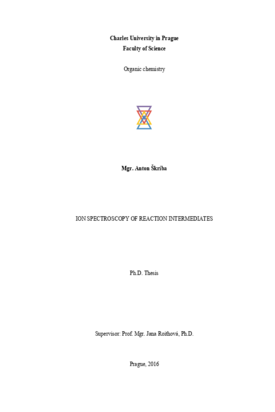Ion spectroscopy of reaction intermediates
Iontová spektroskopie reakčních intermediátů
dizertační práce (OBHÁJENO)

Zobrazit/
Trvalý odkaz
http://hdl.handle.net/20.500.11956/79300Identifikátory
SIS: 95439
Katalog UK: 990021109490106986
Kolekce
- Kvalifikační práce [21483]
Autor
Vedoucí práce
Oponent práce
Stará, Irena
Martinů, Tomáš
Fakulta / součást
Přírodovědecká fakulta
Obor
-
Katedra / ústav / klinika
Katedra organické chemie
Datum obhajoby
27. 5. 2016
Nakladatel
Univerzita Karlova, Přírodovědecká fakultaJazyk
Angličtina
Známka
Prospěl/a
Kombinácia hmotnostnej spektrometrie, infračervenej iónovej spektroskopie a kvantovo-chemických výpočtov poskytuje výborný nástroj pre štúdium štruktúr, vlastností a reaktivity molekúl v plynnej fáze. Predložená dizertačná práca je rozdelená do dvoch hlavných častí. Prvá časť zhŕňa niektoré experimentálne (ESI-MS, iónová spektroskopia) a teoretické (DFT) metódy a stručne popisuje použité prístroje. Druhá časť predstavuje štyri praktické použitia týchto techník v organickej a organokovovej chémii: (1) Vysvetlenie pôsobenia dvoch funkčných skupín para-aminofenolu na miesto protonácie. (2) Porozumenie vplyvu koordinácie striebra a zlata na štruktúru a konformáciu dietylmalonátu. (3) Možnosť rozlišovania medzi jednotlivými izobarickými komplexami a identifikácie kľúčových medziproduktov v reakcii katalyzovanej ruténiom za vzniku C-C väzby. (4) Využitie héliových tagov v infračervenej spektroskopii nielen na určovanie štruktúry ale aj pre porovnávanie DFT metód.
The combination of mass spectrometry, infrared action spectroscopy and quantum-chemical calculations provides a great tool for the study of the structures, properties and reactivities of molecules in the gas phase. This thesis is divided into two main parts. The first part reviews some of the experimental (ESI-MS, ion spectroscopy) and theoretical (DFT) methods used in this thesis and gives a brief description on instrumentation. Second part is presenting four practical applications of gas phase studies in organic and organometallic chemistry: (1) Describing the influence of two functional groups of para-aminophenol on the protonation site. (2) Presenting how the structure and conformation of diethylmalonate is affected by the coordination with silver and gold. (3) Showing the possibility to distinguish between the isobaric complexes and identifying the key intermediates of ruthenium catalyzed C-C coupling. (4) Discussing the possible use of He-tagging infrared spectra not only for structure determination but also for the benchmarking of DFT methods.
